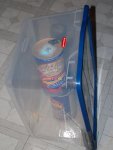Try a solvent, a dye would have to be in a polymer base, and DMF or other strong solvents would possibly make quick work of it.
The strongest, most nasty stuff in a hardware store is the solvent based liquid or gel based paint removers for woodworkers. It tends to contain at least 3 nasty, strong, not for mere mortals, solvents. I've used it to strip some epoxies, so it might make fast work of a dyed lacquer used on optics.
Sounds like you need DPSS pulsed UV or nitrogen at 332 to degrade it.
Steve
The strongest, most nasty stuff in a hardware store is the solvent based liquid or gel based paint removers for woodworkers. It tends to contain at least 3 nasty, strong, not for mere mortals, solvents. I've used it to strip some epoxies, so it might make fast work of a dyed lacquer used on optics.
Sounds like you need DPSS pulsed UV or nitrogen at 332 to degrade it.
Steve
Last edited:




